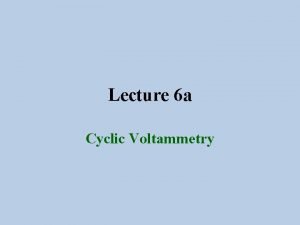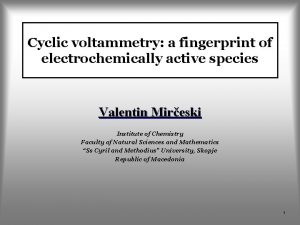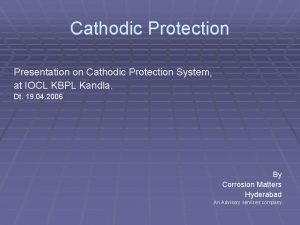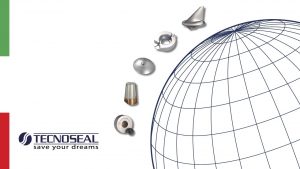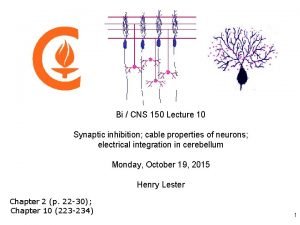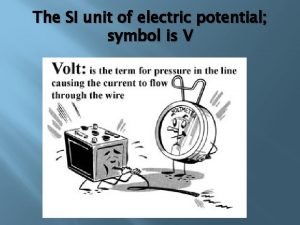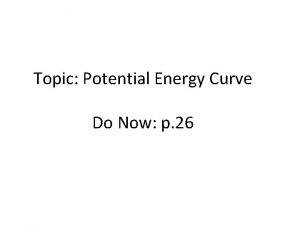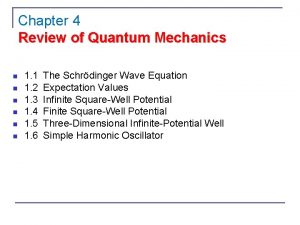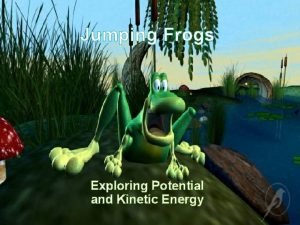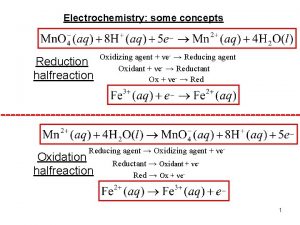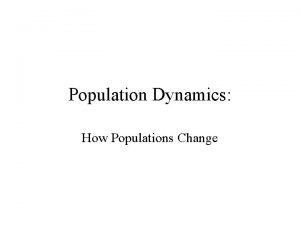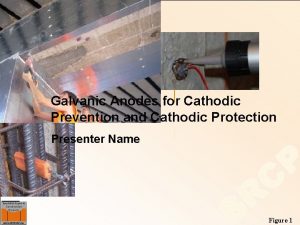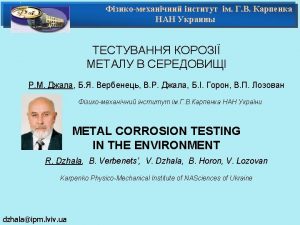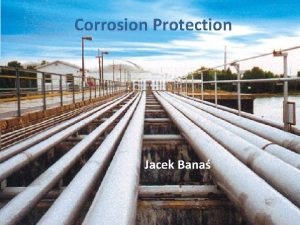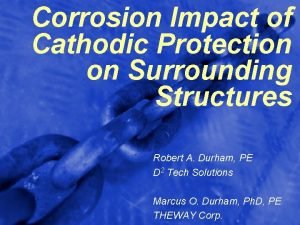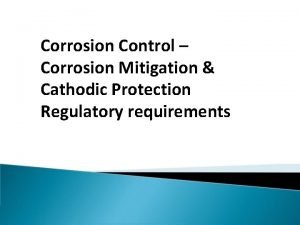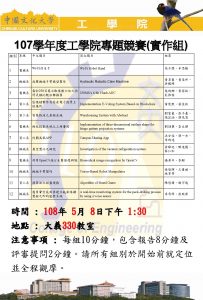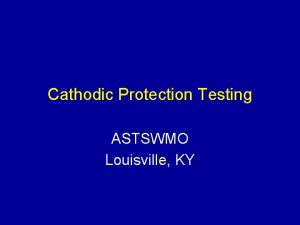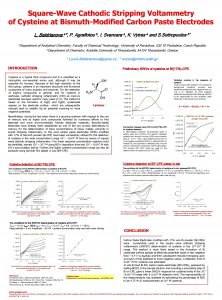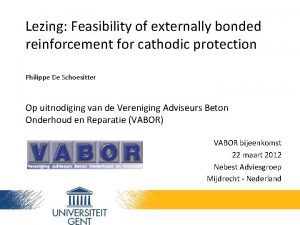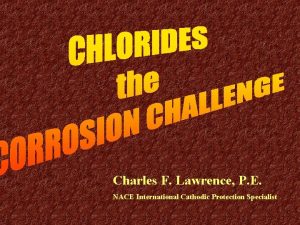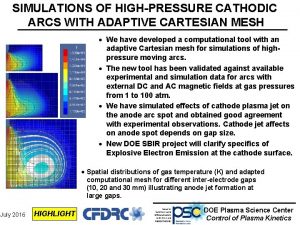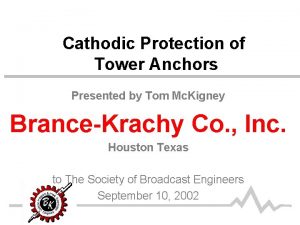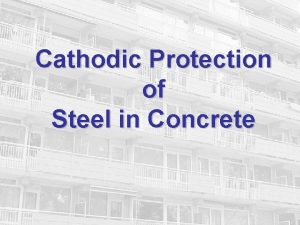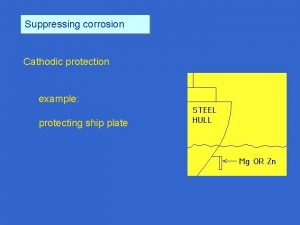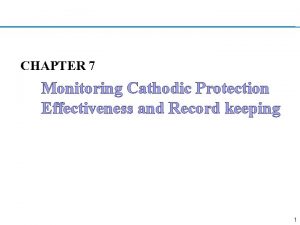current cathodic ic potential potential V V current

















































- Slides: 49

+ current, cathodic ic + potential, - potential, V V - current, anodic ia

+ current, cathodic ic Reduction + potential, - potential, V V Oxidation - current, anodic ia

+ current, cathodic ic When no electroactive species is present, no current flows, no ic nor ia This is what background electrolyte should look like. +V -V +1. 0 V - current, anodic ia

Starting at a + V, Initially no current flows + current, cathodic ic +V -V +1. 0 V - current, anodic ia

If a reducible species is present ic will increase + current, cathodic ic +V -V +1. 0 V - current, anodic ia

And continue to increase + current, cathodic ic +V -V +1. 0 V - current, anodic ia

+ current, cathodic Until all of the species ic is reduced. ic has reached a maximum. +V -V +1. 0 V - current, anodic ia

Then ic decreases until… + current, cathodic ic +V -V +1. 0 V - current, anodic ia

It again reaches the background current level. + current, cathodic ic +V -V +1. 0 V - current, anodic ia

Now the potential is reversed + current, cathodic ic +V -V +1. 0 V - current, anodic ia

And as V is more positive, The reduced species can be Re-oxidixed + current, cathodic ic +V -V +1. 0 V - current, anodic ia

So ia decreases to a maximum + current, cathodic ic +V -V +1. 0 V - current, anodic ia

Where all has been oxidized, + current, cathodic ic +V -V +1. 0 V - current, anodic ia

Then ia decreases, back to the background level. + current, cathodic ic +V -V +1. 0 V - current, anodic ia

Important features: Ec + current, cathodic ic +V -V +1. 0 V -1. 0 V Ea - current, anodic ia

Ec + current, cathodic ic E 1/2 is ~ Eo. Red E 1/2 +V -V +1. 0 V -1. 0 V Ea - current, anodic ia

Using an Fe(3+) heme, Fe is electroactive, (and also the heme!) … + current, cathodic ic All Fe(3+) +V -V +1. 0 V - current, anodic ia

+ current, cathodic ic A little Fe(2+) formed +V -V +1. 0 V - current, anodic ia

+ current, cathodic ic more Fe(2+) formed +V -V +1. 0 V - current, anodic ia

Largest cathodic current, Max rate of Fe(2+) formed + current, cathodic ic +V -V +1. 0 V - current, anodic ia

+ current, cathodic ic Little Fe(3+) left; Less Fe(2+) forms; Decrease in ic +V -V +1. 0 V - current, anodic ia

+ current, cathodic ic all Fe(2+) now +V -V +1. 0 V - current, anodic ia

+ current, cathodic ic +V -V +1. 0 V - current, anodic ia

+ current, cathodic ic +V -V +1. 0 V A little Fe(2+) is re-oxidized to Fe(3+) - current, anodic ia -1. 0 V

+ current, cathodic ic +V -V +1. 0 V - current, anodic ia

+ current, cathodic ic +V -V +1. 0 V -1. 0 V Nearly all Fe(2+) has been oxized - current, anodic ia

+ current, cathodic ic +V -V +1. 0 V -1. 0 V All back to Fe(3+). Cycle could be run again, many times. - current, anodic ia

Important features: Ec + current, cathodic ic +V -V +1. 0 V -1. 0 V Ea - current, anodic ia

Ec + current, cathodic ic E 1/2 for Fe(3+/2+) reduction E 1/2 +V -V +1. 0 V -1. 0 V Ea - current, anodic ia

Working Electrode: Where the redox reaction occurs the black box

Working Electrode: Where the redox reaction occurs the black box Reference Electrode: Defines “ 0” potential for the cell. We use Ag/Ag. Cl

Working Electrode: Where the redox reaction occurs the black box Auxilliary Electrode: Needed to complete circuit. We use a Pt wire Reference Electrode:

the black box Working Electrode: Where the redox reaction occurs Fe(3+) Fe(3+) Fe(3+) Fe(3+) Fe(3+) At start of CV experiment…

the black box Working Electrode: Where the redox reaction occurs Fe(2+)Fe(3+) Fe(3+) Fe(3+) Fe(3+) Fe(3+) Moving up the cathodic current peak…

the black box Working Electrode: Where the redox reaction occurs Fe(2+)Fe(3+) Fe(2+) Fe(3+) Fe(3+) Fe(3+) Fe(3+) Still moving up the cathodic current peak…

the black box Working Electrode: Where the redox reaction occurs Fe(2+) Fe(3+) Fe(3+) Fe(3+) Fe(3+) Fe(3+) After the maximum cathodic current peak…

the black box Working Electrode: Where the redox reaction occurs Fe(2+)Fe(3+) Fe(2+) Fe(3+) Fe(3+) Fe(3+) Fe(3+) Moving down the anodic current peak…

the black box Working Electrode: Where the redox reaction occurs Fe(2+)Fe(3+) Fe(3+) Fe(3+) Fe(3+) Fe(3+) Sill moving down the anodic current peak…

the black box Working Electrode: Where the redox reaction occurs Fe(3+) Fe(3+) Fe(3+) Fe(3+) Fe(3+) At end of CV experiment…

In your CV scans of Fe(porphyrin)Cl, you will see: + ic -V +V Interpretation? ? Interpretation - ia

How is the range of Heme Potentials in Respiration adjusted?

The Question asked: Can changing Heme substituents vary Fe(3+/2+) redcution potentials?







 Anodic peak current
Anodic peak current Cathodic peak current
Cathodic peak current Cathodic protection presentation
Cathodic protection presentation Cathodic protection monitoring system
Cathodic protection monitoring system Passive cathodic protection
Passive cathodic protection Pcr cathodic protection
Pcr cathodic protection Define electric potential and potential difference.
Define electric potential and potential difference. Refractory period in action potential
Refractory period in action potential Electric potential energy
Electric potential energy How to find pressure potential
How to find pressure potential Action potential resting potential
Action potential resting potential Decremental graded potential
Decremental graded potential Volts to ev
Volts to ev Source of bioelectric potential
Source of bioelectric potential Water potential
Water potential Peelectric
Peelectric Negative water potential
Negative water potential Action potential resting potential
Action potential resting potential Graded potential definition
Graded potential definition Electric potential inside non conducting sphere
Electric potential inside non conducting sphere Hypopolarization
Hypopolarization Calculating solute potential
Calculating solute potential Electrical potential
Electrical potential Difference between sales potential and market potential
Difference between sales potential and market potential Action potential definition
Action potential definition Define electrical potential difference
Define electrical potential difference Rocuronium dose
Rocuronium dose Neuronal pool
Neuronal pool Current potential difference and resistance
Current potential difference and resistance Pinch off voltage
Pinch off voltage All of the heat produced by sma weld stays in the weld.
All of the heat produced by sma weld stays in the weld. Y connected generator
Y connected generator Line current and phase current
Line current and phase current In a delta connected source feeding a y connected load
In a delta connected source feeding a y connected load Hazard based safety engineering
Hazard based safety engineering Drift current and diffusion current
Drift current and diffusion current Holding current and latching current
Holding current and latching current Phase to phase voltage
Phase to phase voltage Kcl mesh analysis
Kcl mesh analysis Ceramic composition resistors
Ceramic composition resistors Drift current and diffusion current in semiconductor
Drift current and diffusion current in semiconductor Energy band diagram of pn junction diode
Energy band diagram of pn junction diode Reversal potential
Reversal potential Symbol for electric potential
Symbol for electric potential Potential energy diagram
Potential energy diagram Grade 7 natural science term 3 worksheets
Grade 7 natural science term 3 worksheets Finite potential well
Finite potential well Kinetic frog
Kinetic frog Redox potential table
Redox potential table Biotic potential definition
Biotic potential definition
